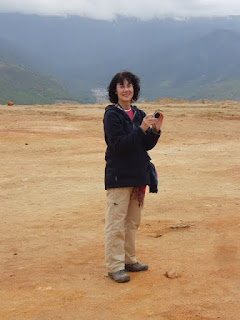So, a pretty eclectic bunch of topics today. On Saturday, I went to National Day with Ayumi, a Japanese nurse who is working in the ICU under the auspices of JICA, the Japanese international development agency. They run a program quite similar to the Peace Corps. She is here for two years. She is a very good ICU nurse from a highly developed medical system. When we have compared notes, there are no differences of significance between US and Japanese ICU care.
We got to sit up in a VIP area again, and got a good look at the festivities. Some of the dances and pageantry were a bit different from last year, with mask dances as well as other presentations.
 |
| Royal Bhutanese Army Marching Band |
 |
| Traditional procession before king arrives |
 |
| Group of monks |
 |
| The King |
 |
| Buddhist benediction before the King's speech |
 |
| Mask Dancers |
 |
| Bhutanese Bagpipe Band |
We did not meet the King this time; he spent most of his time in the general admission stands. Several members of the royal family said hello (his sisters and younger brother) and chatted a bit. Ayumi showed me a new restaurant after the proceedings where we had brukpa, which is a thick noodle thukpa (noodles, vegetables, preserved meat) that is very spicy but extremely good.
Sunday was chores and shopping. Renewed my stock of vegetables, and got an additional heater and an Indian pressure cooker. The pressure cooker is, well, interesting. To put the lid in (that is not a typo) one puts the two handles at 90 degrees to each other, you then slide the top in, and then align the handles. A rubber gasket makes the seal, and you then squeeze the two handles together until the metal loop on the lid catches the lip on the pot. Pop on the regulator and you are good to go. Definitely not Mom’s Presto. On the other hand, I was able to make some dahl (lentil soup) in 10 minutes instead of 45. I know it's kinda weird that I spent so much time describing a pressure cooker, but the design was intriguing. In particular, it is an absolute HORROR to clean. Food gets in under the lip on the pot and it's difficult to see whether you really do have the thing clean or not. Maybe it's cheaper to make???
 |
| Unassembled; black ring on the lid is the gasket. |
 |
| Lid goes inside the pot. |
 |
| Fully assembled. Note ring on the end of the handles. |
So, I went to this store called the Eight Eleven (none too subtle, eh?) It is actually quite a good store, get lots of good stuff there, easy to maneuver, good choice. They had some baked goods, one of which, I swear, looked exactly like a challah.
I had to laugh. It’s called a sweet bread. Real challah is sweeter, and uses egg. This did not. Still pretty good, though.
This morning, I was minding my own business walking to work down Doebum Lam, which is one of the three or four main streets in Thimphu that run parallel to the river; it is sufficiently important that some portions have a median divider. The hospital is directly on this street. There were these two guys herding horses down the middle of the street during rush hour, to the consternation of drivers, especially taxis. Apparently totally legal, police just watching, no one interfering.
The final installment today is medical, and also shows another way of doing things. The picture below is of an incredibly cheap, simple pleural drainage system. Apparently they almost never use suction here.
(chest tubes picture)
Well, that’s it for today. Life is nothing if not interesting.


























